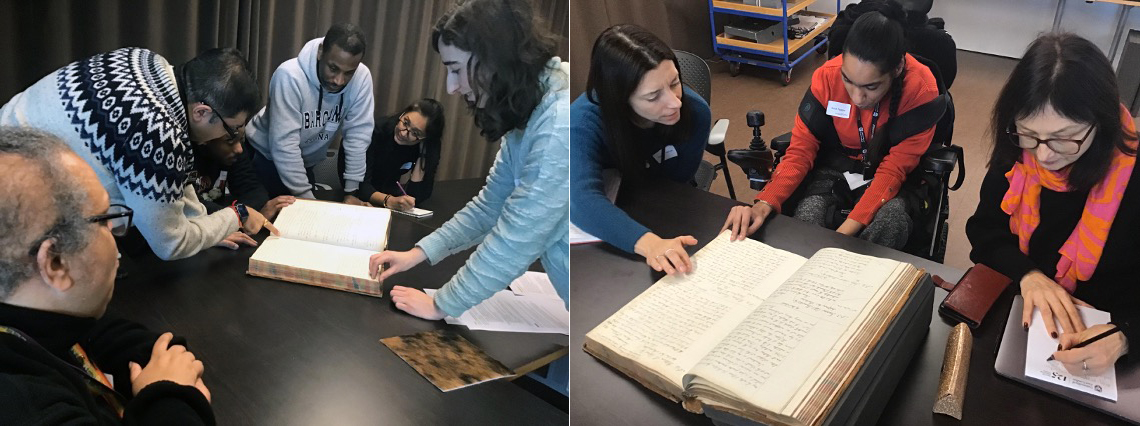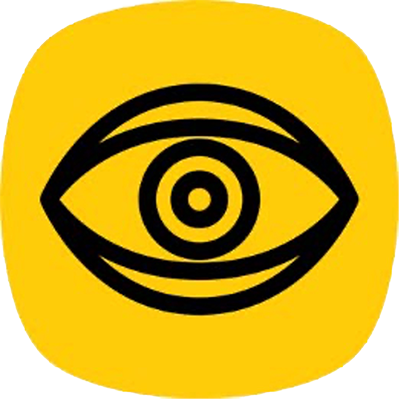The Rix Inclusive Research Team and purpleSTARS had a terrific start to 2024 and on Wednesday 10 January we were invited to visit The National Archives in Kew, London.
Inclusive Research Team: Kate Allen, Rufaro Asuquo, Ajay Choksi, Kiran Dillon, Baljit Kaur, Kanchan Kerai, Gosia Kwiatkowska, Lee Phillips, Samantha Walker.

Right – Rachel from The National Archives and Baljit feel the pages of an old book from the archive while Gosia takes notes of the sensory experience.
The purpose of the visit was to provide our expertise and help the National Archives team to explore how sensory experiences can be used to engage with and understand the materiality of their archival collections/objects.
On arrival, we were met by Sarah Petter, Senior Engagement Manager, Collection Care, Rachel Hillman, Deputy Head of Education and Outreach, Kathryn Collins, Families and Young People’s Programme Officer and Natalie Brown, Head of Audiences, Collection Care. Everyone was very excited to see the collection of objects they had for us to explore.
Our favourite items were journals and very old notebooks that were written on different types of parchment from over 700 years ago. We recorded which senses we used during our exploration of the different documents and objects.
They looked very old; some books were huge.
The colour of the paper was like coffee.
The writing was too small to read and in Latin or in old-fashioned writing.
They looked like Shakespeare’s notebooks!
The pages felt smooth and soft.
The covers felt rougher.
Some pages felt heavy some bumpy changed by water damage.
Other pages and documents felt very delicate.
They smelt like old newspapers to some of us.
Some of us described the smell as old wood.
A bit musty, mouldy, hint of vanilla.
The smell of books and libraries.
One book smelt like Sherlock Holmes!
The pages turning sounded like leaves rustling, some of us thought it sounded crispy.
Soft quiet library sounds of book pages carefully being turned.
Sound of unsticking very old pages.
Parchment is a writing material made from specially prepared animal skin, usually, cow, sheep, goat or calf. We learnt that the process to make parchment is a long and smelly one.
We learnt that some books were made from tree bark that was cheaper than parchment and led to the term ‘Pulp Fiction’. These books were the smelliest, and we learnt the smell was caused by the ‘lignin’ in tree bark, and that the smell was an indication that the book was decaying.
We also enjoyed looking and touching the collection of wax seals and their plaster moulds. They were very intricate and elaborate in their designs, and some of them were very big and heavy! We wondered how such heavy seals could be attached to documents and not break. We also discussed what symbols we would design for our own seals.


A seal is a piece of wax that has a unique and personalised design stamped into it. It is attached to a document to guarantee its authenticity.
We also looked at other objects, for example microfilms that are being preserved by the National Archives. Unfortunately, they are very difficult to preserve, and they degrade. They have a distinctive smell – they smell like ‘fish, they smell like a bad fish’ – said Kiran. Baljit also thought that the smell was unpleasant. ‘They smell like rubbish’ she said. Rufaro felt that the microfilms smelled like ‘fish and chips with vinegar and that makes me hungry’.

Everyone thoroughly enjoyed the visit. We are certain that people with a lived experience of disability, learning difference, and the wider community will benefit from being given the opportunity to access The National Archives documents and objects through sensory exploration.
We look forward to presenting our feedback and building a partnership with The National Archives in future research endeavours.
Video documentation from visit: Smelling books
Video documentation from visit: Touching wax seals
The National Archive
The National Archive is the official archive and publisher for the UK Government for England and Wales.
They have documents they look after that are over a thousand years old.
Find out more about purpleSTARS
Written by Kanchan Kerai and Kate Allen





